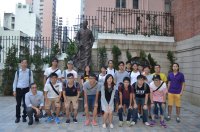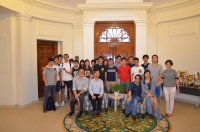
Contents
|
|
Related
|
|
|
|
| Level: | 4 |
| Credit units: | 12 |
| Course title: | Integrated Capstone Experience |
| Duration: | Whole
year |
| Prerequisite: | None |
| Assessment methods: | Practical
Work (100%) |
| Course Website: | http://me.hku.hk/bse/capstone/ |
The Capstone Experience: A
Definition
The undergraduate capstone experience is
designed to bring reflection and focus to the
whole of the college experience. It should
encourage students to integrate facets of their
area of concentration with important concepts
from related disciplines. This culminating
college experience should focus on some feature
of the student's area of concentration and
should require the disciplined use of skills,
methodology, and knowledge taught throughout the
undergraduate curriculum.
The
capstone experience should focus on integration
and/or application of knowledge and skills
rather than only on the acquisition of new
knowledge and skills. It should be
student-driven, requiring students to take
ownership and responsibility for the experience.
The Meaning of Capstone
Project:
Also called a capstone experience, culminating project, or senior exhibition, among many other terms, a capstone project is a multifaceted assignment that serves as a culminating academic and intellectual experience for students, typically during their final year of high school or middle school, or at the end of an academic program or learning-pathway experience.
Capstone projects are generally designed to encourage students to think critically, solve challenging problems, and develop skills such as oral communication, public speaking, research skills, media literacy, teamwork, planning, self-sufficiency, or goal setting. In most cases, the projects are also interdisciplinary, in the sense that they require students to apply skills or investigate issues across many different subject areas or domains of knowledge.
Related
previous courses:
- BBSE3008 Design Project (BBSE3409)
- HKU Interdisciplinary Design Project
- BBSE3002 Applied Research Project (BBSE4402)
Useful References:
There is no required textbooks for this course. Additional references and materials on the course topics will be provided over the course. The following are some suggested reading materials.
- Bownass, D. A., 2001. Building Services Design Methodology: A Practical Guide, Spon Press, London & New York. [696 B787 b][eBook via EBSCOhost]
- Churcher, D., 2009. A Design Framework for Building Services: Design Activities and Drawing Definitions, 2nd ed., Building Services Research and Information Association, Bracknell, Berkshire, England. [692.1 C56]
- Churcher, D., Sands, J. and Parsloe, C., 2008. Model Demonstration Project: Apply HVAC Building Services Calculations, Building Services Research and Information Association, Bracknell, Berkshire, England. [696 C55]
- CIBSE, 2008. CIBSE Concise Handbook, 3rd ed., Chartered Institution of Building Services Engineers, London. [696 C5]
- De Saulles, T., 2002. An Illustrated Guide to Mechanical Building Services, Building Services Research and Information Association, Bracknell, Berkshire, England. [P 658.25 D44]
- Hall, F. and and Greeno, R., 2013. Building Services Handbook, 7th ed., Elsevier, Oxford, U.K. [690 H17]
- Hall, F. and and Greeno, R., 2011. Building Services Handbook, 6th ed., Elsevier, Oxford, U.K. [690 H17][ebook via ebrary]
- Hastings, P., 2005. The Illustrated Guide to Electrical Building Services, 2nd ed., Building Services Research and Information Association, Bracknell, Berkshire, England. [621.3 D27]
- Hawkins, G., 2009. Building Services Job Book: A Project Framework for Engineering Services, BG 1/2009, Building Services Research and Information Association, Bracknell, Berkshire, England. [AV 690 H39 CDROM + licences]
- Langmaid, J., 2004. Choosing Building Services: A Practical Guide to System Selection, Building Services Research and Information Association, Bracknell, Berkshire, England. [P 690.24 L26][SL 690.24 L26 CDROM]
- Pennycook, K. A., 2010. Illustrated Guide to Mechanical Cooling, BG 1/2010, Building Services Research and Information Association, Bracknell, Berkshire, England. [697.93 P41]
- Pennycook, K., 2009. The Illustrated Guide to Ventilation, Building Services Research and Information Association, Bracknell, Berkshire, England. [P 697.92 P416 ]
- Pennycook, K., 2007. Design Checks for HVAC: A Quality Control Framework, BSRIA Guide BG 4/2007, 2nd ed., Building Services Research and Information Association, Bracknell, Berkshire, England. [697 R1][AV 697 P416]
- Pennycook, K. 2006. Design Checks for Electrical Services, Application Guide BG 3/2006, Building Services Research and Information Association, Bracknell, Berkshire, England. [628.0941 P41][AV 621.31924 P41 d]
- Pennycook, K. 2006. Design Checks for Public Health Engineering, Application Guide BG 2/2006, Building Services Research and Information Association, Bracknell, Berkshire, England. [621.31924 P4][AV 621.31924 P4 d]
- Pennycook, K., Churcher, D. and Bleicher, D., 2007. A Guide to HVAC Building Services Calculations, 2nd ed., Building Services Research and Information Association, Bracknell, Berkshire, England. [AV 697 G94][AV 697 G94 CDROM]
- Race, G. L. and Mitchell, S., 2003. A Practical Guide to HVAC Building Services Calculations, Building Services Research and Information Association, Bracknell, Berkshire, England. [697 R1 p][AV 697 R1 p8]
- Rush, R. D., 1986. The Building Systems Integration Handbook, American Institute of Architects, New York. [720 R95]
- Building Services Engineering Lecture Notes, [http://www.arca53.dsl.pipex.com/]
- Building Design and Construction Services Directory (UK), www.buildingdesign.co.uk
- Modern Building Services, www.modbs.co.uk
- Useful Info for Building Services Design, www.hku.hk/bse/capstone/bs-design.htm
- Useful References for Detailed Design: Building Services Systems, www.hku.hk/bse/capstone/detail_design_references.htm


